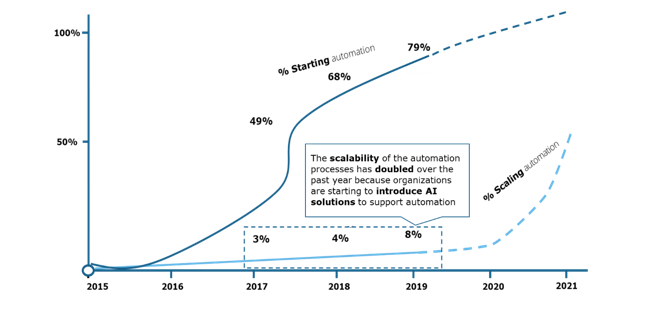
Over the last years, a growing number of companies, driven by the need to optimize their operations and increase the efficiency of their processes, have increasingly implemented robotic process automation (RPA) solutions.
Companies have been adopting this technology mostly to automate simple and repetitive tasks with the aim of freeing up the workforce to focus on high-value added activities, while ensuring higher quality of processed data and producing results with a lower margin of error.
Thanks to its rapidity of implementation and low needs of investments (if compared to traditional IT solutions), RPA technology paced up across several industries, moving towards its maturation.
Nowadays organizations that tackled the RPA implementation are exhausting many of the low-value opportunities automatable through simple task-based robotics [1], and they are facing difficulties in evolving their automation path.
Main challenges to Automation Scaling
A Deloitte study shows that out of the 80% of the surveyed companies that have started RPA initiatives, only the 8% are scaling this technology [2].
Figure 1: Scalability of RPA solutions

Indeed, several challenges may emerge when scaling the RPA technology, the nature of which can span from technical to organizational matters:
- Process Fragmentation: business processes tend to be very complex and heterogeneous composed of several tasks, systems and under the ownership of different organizational units. Moreover, companies have often used RPA technology to automate nuclear tasks within the processes instead of targeting the end-to-end scope.
The focus on the simplest tasks is related to RPA technology limitations. Indeed, a mere RPA solution cannot:
- emulate expert activities in evaluating decisions;
- comprehend unstructured text or, generally speaking, analyse unstructured input data (e.g. scanned documents);
- manage scenarios where it is not possible to define deterministic business rules without a significant effort [3].
- Lack of RPA vision: one of the main constraint is the lack of a clear and shared long-term vision and strategy within organizations. It is necessary to clearly define what goals need to be achieved, which and how many stakeholders must be involved across the organization and the necessary key-skills in the company.
- Inadequate involvement of IT and Business departments: the introduction of RPA technologies require a structural change inside the company involving on the one hand Business departments in order to identify and select the processes to be automated and on the other, the involvement of the IT department to ensure that the new technology is effectively integrated within IT systems [4].
From RPA to Intelligent Automation
To further increase the benefits derived from robotics and to reach effectively an end-to-end business process automation, it is therefore essential to start looking beyond RPA and to take into considerations a portfolio of different automation technologies.
A Deloitte study shows that companies are already moving to include in their digital portfolio the combination of intelligent solutions with RPA to improve the efficiency and the responsiveness of the processes, to reduce related costs, and to improve accuracy and customer experience [5].
In order to deepen the level of automation of their business processes, organizations can utilize different solutions that overcome several of the RPA technology limitations:
- BPM: Business Process Management tools can be integrated with a RPA solution in order to automate process workflows by defining tasks, assigning them to certain actors, organizing activities into processes, monitoring and reporting the status of the activities. An use case of BPM in the Financial Services industry can be found on the credit granting system for the creditworthiness analysis;
- OCR: Optical Character Recognition allows detecting characters within digital documents and transferring them to digital text (e.g. scanned and structured documents);
- ICR: Intelligent Character Recognition is handwriting recognition system that allows fonts and different styles of handwriting to be learned by a computer during the processing to improve accuracy and recognition level;
- Artificial Intelligence: AI encompass a set of tools, algorithms and mathematical models based on sample data, with the aim of making predictions or taking decisions. The current applications of AI are very extensive and can easily cover classic tabular data (e.g. the excel sheet), text, images and sound in types of use cases ranging from the classification of texts to the generation of new images while the limit, today, seems to be the large amount of data to be used in training.
The adoption of such technologies represents the switch from a “traditional” automation based on robotics, to an Intelligent Automation, where the goal is the end-to-end process rather than the rule-based, specific tasks that may compose it.
Main challenges and solutions
Nonetheless, the journey towards the Intelligent Automation is not without challenges, since both technical and organizational aspects must be carefully considered:
- Technology Integration: intelligent technologies must be integrated within the existing IT systems and workflows focusing on system infrastructure, data storage, data transfer to other systems, training models and tests phases. At the end it is crucial to consider an orchestrator component to design and manage the automation of a business process;
- Data: the efficacy of the introduction of intelligent technology heavily depends on the data adopted for the training phase. Therefore, possible data issues, from data quality to regulatory limitations, have to be considered when extending the automation portfolio;
- Change management: the adoption of new technologies also requires a careful and structured change management process, as digital innovation requires a well-defined planning of the processes transformation as well as the evolution of the people involved in the affected activities;
- Business model standardization: standardization of business models and processes is a fundamental pre-requisite for companies that want to start a progressive rollout of the Intelligent Automation solutions. Simplifying the processes requires a high maturity degree, the presence of clear operating rules and the minimization of possible exceptions to be managed [6].
Therefore, in order to approach correctly the Intelligent Automation journey, it is crucial to define a holistic strategy shared by the whole organization that also allows to identify the correct use cases for adoption and to transcend the organizational silos.
The disruption of COVID-19
Millions of companies are facing new challenges with the spread of the COVID-19 virus, reviewing their business and operating models, in order to mitigate the unexpected disruption that the virus could have on businesses in a long-term prospective.
In this scenario, new tools and solutions represent a critical enabler in navigating these unforeseen challenges, by supporting the companies in surviving the disruption caused by the sanitary emergency and which may alter the standard way of working.
Therefore, Covid-19 could also represent an opportunity for companies to approach strategically the Intelligent Automation journey by leveraging on the main benefits that this solution provides in such a disrupted context:
- Ensure business continuity: with most of the core activities interrupted and facilities locked down, organizations are striving to maintain the continuity for the activities necessary for keep the business up and running. A diffusion of E2E automated processes helps in mitigating the risks due to operations stops;
- Facilitate remote work: automated operations can facilitate the execution of smart working, for instance by automating the processes that involve systems that can be accessed only from the organization establishments;
- Reduce costs: thanks to the possibility of freeing up resources to dedicate to more valuable activities and by reducing operative risks cost, automation will also represent a key elements for efficiency and cost reduction, that will determine which organizations will be able to overcome the economic downturn caused by the sanitary emergency.
Conclusion
The adoption of intelligent technologies to push process innovation beyond the simple automation of individual tasks, despite being characterized by complex challenges, can represent a great opportunity for the company that aims to remain competitive in the market and achieve strong results.
To fully understanding the real benefits of new technologies in terms of increases in productivity, efficiency, precision and quality, it is necessary to make structural changes both at an organizational and architectural level.
Beyond defining a long-term vision focused on the digital innovation shared with all the main stakeholders, it is necessary to rethink the processes and invest in employees and training to remain competitive on the market, especially in an unstable context like the current one stressed by the COVID-19 emergency.
There is no univocal and standard approach for all companies, as some are still in an early stage of adoption while others are proceeding to scale this type of technology.
It is crucial to understand that innovative solutions alone do not create competitive advantages but rather it is likely that a real sustainable competitive advantage will be obtained by investing in human resources in order to create synergies and efficiency across the whole company.
Authors:
Alessandra Ceriani – Partner Deloitte Consulting
Andrea Leuzzi – Director Deloitte Consulting
Alberto D’Elicio – Senior Manager Deloitte Consulting
Giuseppe Scotti – Senior Consultant Deloitte Consulting
Giuseppe Puma – Consultant Deloitte Consulting
[1] Deloitte Insights, Automation with intelligence. Reimagining the organization in the ‘Age of With’, 2019.
[2] Deloitte analysis, 2019.
[3] M. Tomasi, A. Ceriani, Verso la RPA transformation di successo. Sviluppo e governo RPA, 2019
[4] Deloitte, Understanding the challenge of implementing your virtual workforce. Robotic Process Automation as part of a new social-technological paradigm, 2018
[5] Deloitte Insights, Automation with intelligence. Reimagining the organization in the ‘Age of With’, 2019
[6] Deloitte, Le prospettive future dell’Intelligent Automation, secondo le aziende italiane. Un’indagine sulle sfide e sulle opportunità attese dalla convergenza tra automazione e intelligenza artificiale, 2019



